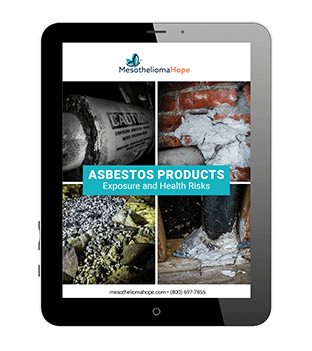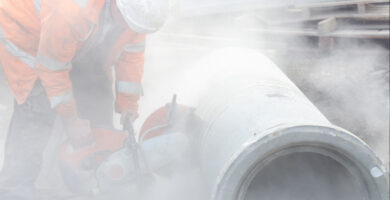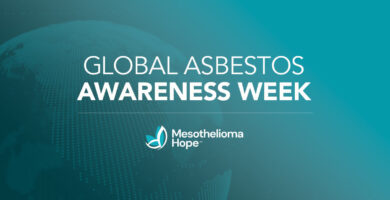Pleural mesothelioma is a rare and fatal cancer caused by exposure to asbestos. The word “pleural” relates to the lungs. There are other types of mesothelioma that affect other tissues, such as the lining of the heart, chest cavity, gastrointestinal system, and reproductive organs.
The signs and symptoms of pleural mesothelioma can look very much like other asbestos-related diseases. It is important to be diagnosed by a specialist since an expert will provide you with access to the most appropriate treatments. A diagnosis may also open up access to financial compensation.
Pleural Mesothelioma
Pleural mesothelioma is caused when microscopic asbestos fibers become embedded in the lining of the lungs. Exposure usually occurs during work duties. The tiny fibers become embedded in the lining of the chest or abdominal cavity and are impossible to remove.
When the asbestos fibers are inhaled in high quantities, they can develop into cancerous tumors. These tumors are known as pleural mesothelioma.
Symptoms and Signs of Pleural Mesothelioma
Mesothelioma symptoms do not appear until many years after a patient’s initial exposure to asbestos. Furthermore, many symptoms are similar to those of other diseases, so they are often misdiagnosed and mistreated.
Some of the signs and symptoms include:
- Chest pain
- Fluid surrounding the lungs
- Shortness of breath
- Fatigue
- Chronic coughing
- Chronic phlegm
- Wheezing
- Coughing up blood
- Pleural plaques
Pleural plaques are a natural form of collagen in the tissue of the pleural lining (the lining of the lungs) that hardens over time. It is caused by the body’s immune response to the foreign and harmful asbestos fibers.
On its own, pleural plaques are harmless. However, it is often an indicator of a more serious disease, such as mesothelioma or asbestosis. There are no symptoms, but it is visible on CT scans.
Lung Diseases With Similar Symptoms
There are other lung diseases that have signs and symptoms that are very similar to those associated with mesothelioma. Because of these similarities, it is important to be diagnosed by a specialist who has been trained to differentiate between lung diseases like mesothelioma, asbestosis and lung cancer.
Asbestosis
Asbestosis is caused when asbestos fibers are inhaled and lodge in the lungs. The lungs scar and become stiff. Sometimes, the growth of excess tissue, known as fibrosis, occurs.
Because the stiffened lung tissue cannot expand and contract properly, breathing becomes excruciatingly painful and victims often succumb to lung or heart failure, essentially due to suffocation. Unfortunately, there is no known cure.
Asbestosis Signs and Symptoms
- Persistent dry cough
- Chest pain
- Shortness of breath
- Chronic fatigue
- Loss of appetite
- Fingertips and toes that appear wider and rounder than normal (clubbing)
- Pleural Plaques
Asbestosis Treatment Options
Aside from a lung transplant, there is no treatment available. Many patients will use oxygen therapy and medication to manage their pain. It is highly recommended that the patients do not smoke, as this aggravates the disease.
Asbestosis Facts
- Asbestosis is benign. It can worsen, but it is not cancerous and it cannot spread to other organs.
- There is an increased risk of developing lung cancer—this is especially true if you smoke or have a history of smoking.
Lung Cancer
While mesothelioma can develop in the lining of the lungs, lung cancer develops inside the lungs themselves. Lung cancer can be caused by inhalation of asbestos fibers. Studies of people who worked with asbestos show that they develop lung cancer more often than the rest of the population.
It’s difficult to estimate the number of lung cancer deaths caused by asbestos due to the large number of other carcinogens known to cause lung cancer. However, it’s estimated that many more people die of asbestos-related lung cancer than from mesothelioma or asbestosis.
One study, using statistics from the Centers for Disease Control, found that from 1999 to 2013 120,000 to 160,000 Americans died of lung cancer caused by asbestos exposure. This is thought to be a conservative estimate.
Studies like this suggest that lung cancer causes more deaths than asbestosis and mesothelioma.
Lung Cancer Signs and Symptoms
- Coughing
- Wheezing
- Shortness of breath
- Coughing up blood
- Weight loss
- Weakness
- Fever
- Pleural plaques
Lung Cancer Treatment Options
There are many ways to treat lung cancer, and often a complex approach is taken that incorporates some of the following treatments:
- Surgery
- Radiotherapy
- Chemotherapy
- Targeted therapy
- Bronchoscopy
Legal Options for Asbestos-Related Diseases
While mesothelioma-specific funds are not accessible to people battling other lung diseases, compensation is still available.
Asbestos is dangerous and can cause many illnesses. It’s critical to ensure you have been diagnosed properly—there are many similarities between mesothelioma and other diseases caused by asbestos. In order to receive the best treatment, it’s vital to know which disease you are fighting and consider all your available options.
For more information on getting a second opinion on your diagnosis, contact our Justice Support Team today. Call us at (866) 608-8933 or request a FREE Mesothelioma Justice Guide to better understand your legal options.










